Dublin: Distinctly Irish and Rich in History
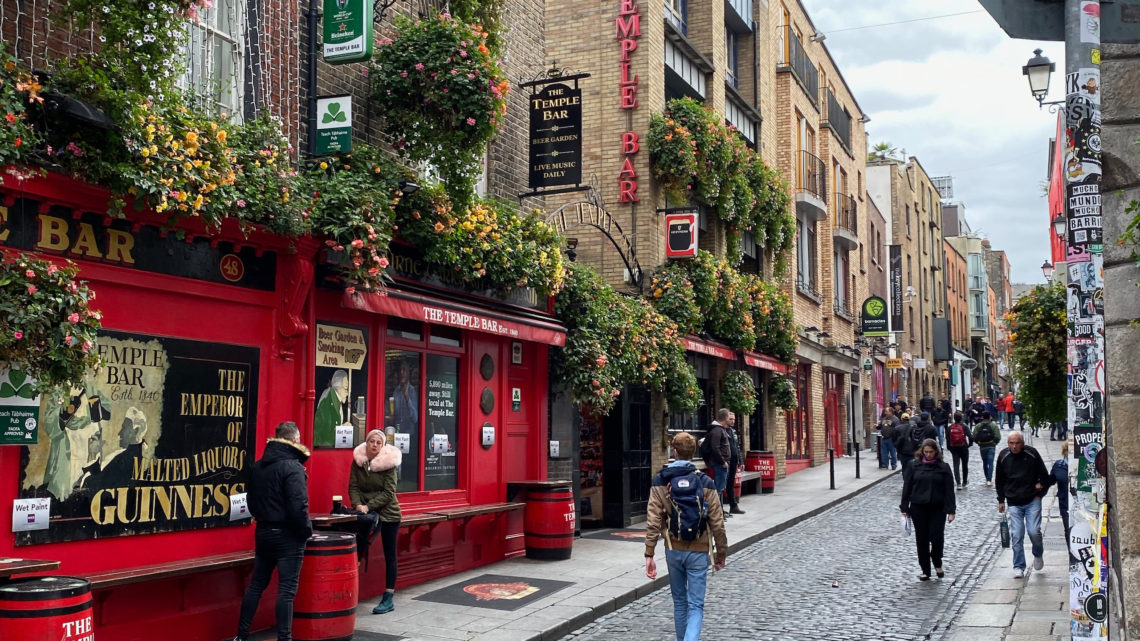
Having grown up in the Boston area, I was always surrounded by a large Irish population. From the high number of popular Irish pubs to the lively celebrations on St. Patrick’s Day, I could tell that these people were proud of their heritage. Whenever I’d ask my friends about their European travel bucket list, Ireland was a common answer. I was eager to learn about Irish history and culture myself, and thus, I decided to include the Emerald Isle as a stop on my recent month-long Europe trip.
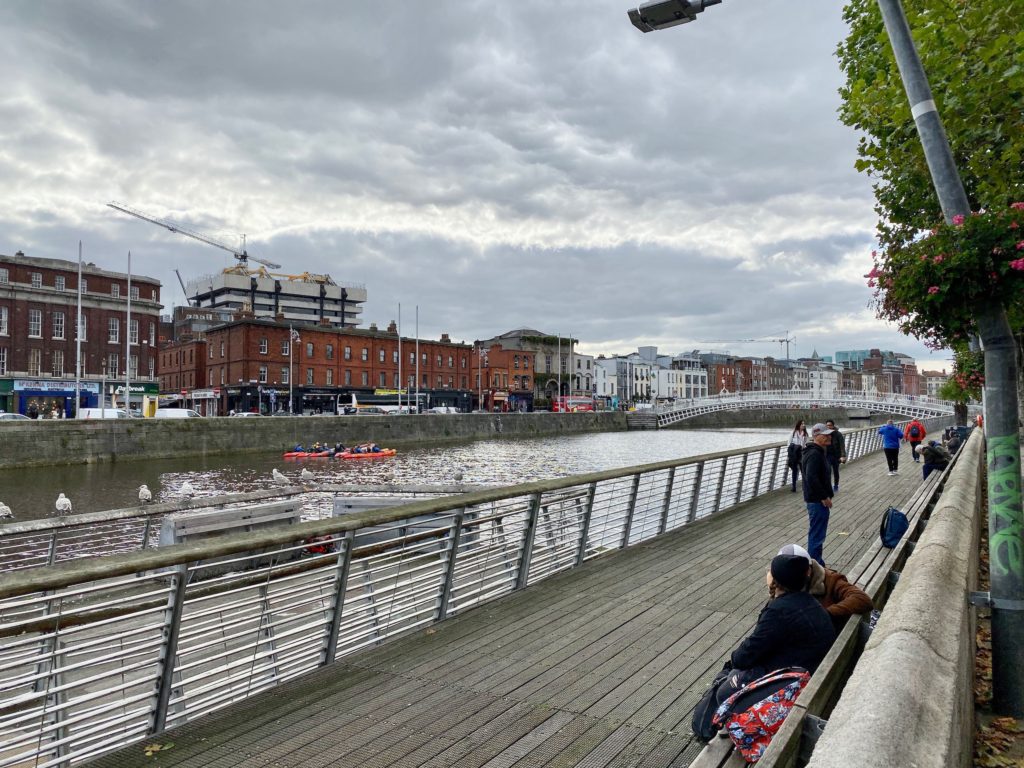
Naturally, I started my Irish journey in the country’s capital: Dublin. At first glance, this riverside city appears a bit gritty. However, once I began exploring its streets and alleys, I discovered a place that was both rich in culture and history, with a mix of old and new buildings. I began my exploration at the River Liffey: the main waterway through the city center. From here, I could see a variety of building types along the water, as well as an array of bridges. One of these, the Ha’penny Bridge, is an iconic cast-iron pedestrian crossing that connects the North City neighborhood with the famous Temple Bar area. It was also the starting point of my walking tour around the city!
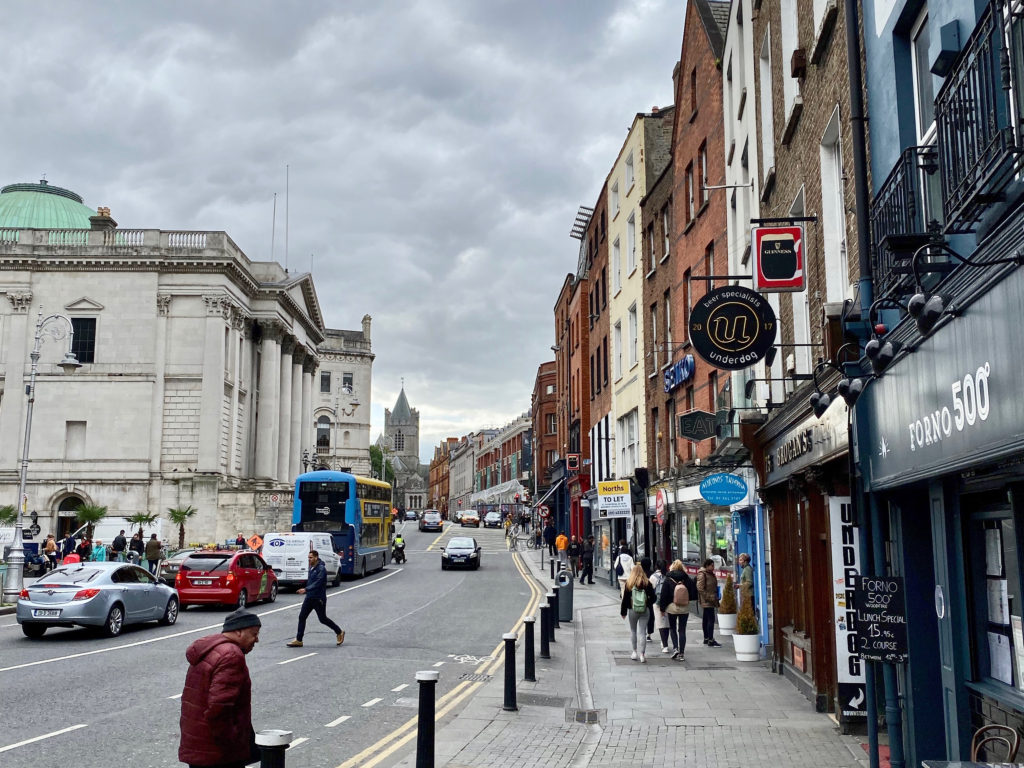
I participated in the tour with another one of my hostel mates, Felicitas (Fee for short,) who is from Germany. We met up with a local Irish guide who began walking our group towards some of Dublin’s most prominent sites. While on the tour, she began talking about Ireland’s history, which has a dark past. In particular, the Great Irish Famine of the 19th century led to a sharp decline in the country’s population. The famine was the primary cause of the mass emigration of the Irish to other parts of the world, including America. This long and treacherous journey was one that few survived. As a result, many Irish descendants are proud of their heritage and admire their ancestors’ bravery for emigrating during this challenging time.
Dublin Castle
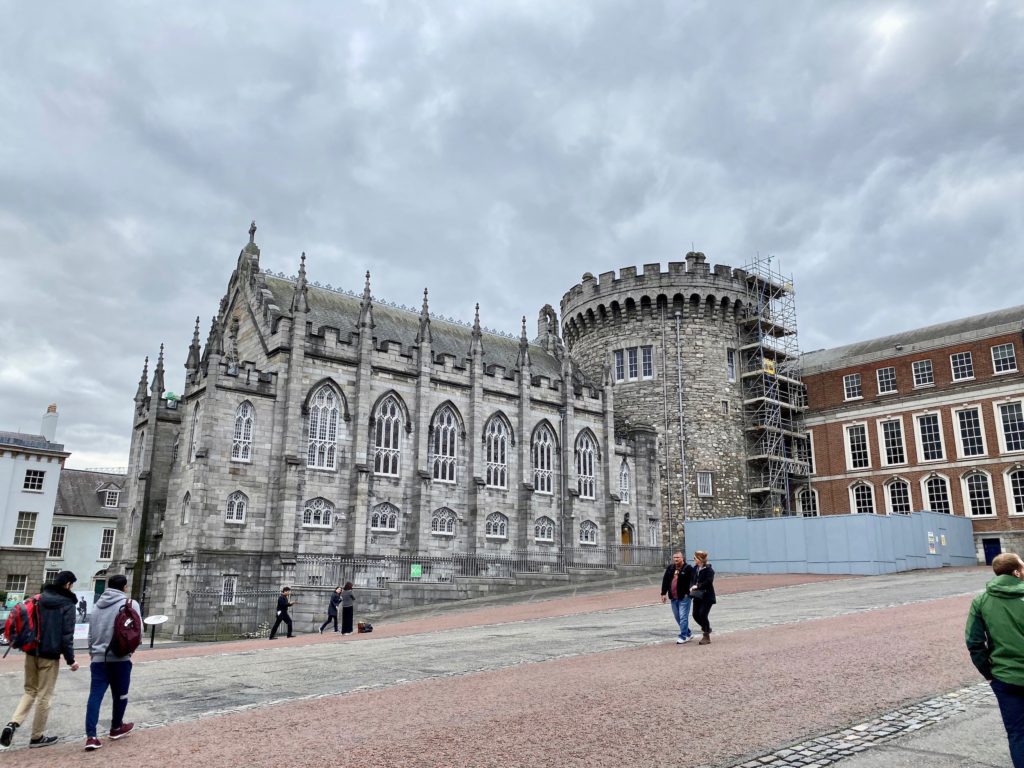
After a short walk, we arrived at our first stop at Dublin Castle. Over the years, this castle has been used for various purposes. Its original function was to defend the city during the 13th century. Most of today’s buildings were built during the 18th century, replacing a complex that was largely damaged by fire. The only portion of the original Norman castle that still exists is the Records Tower. Beside the tower is the Chapel Royal, a lovely Gothic revival building dating back to the early 19th century. It replaced an older church that suffered foundation damage from its location on soft ground. Although the church is stone on the outside, it has a timber framing system to make it light enough to suit the soft ground beneath it.
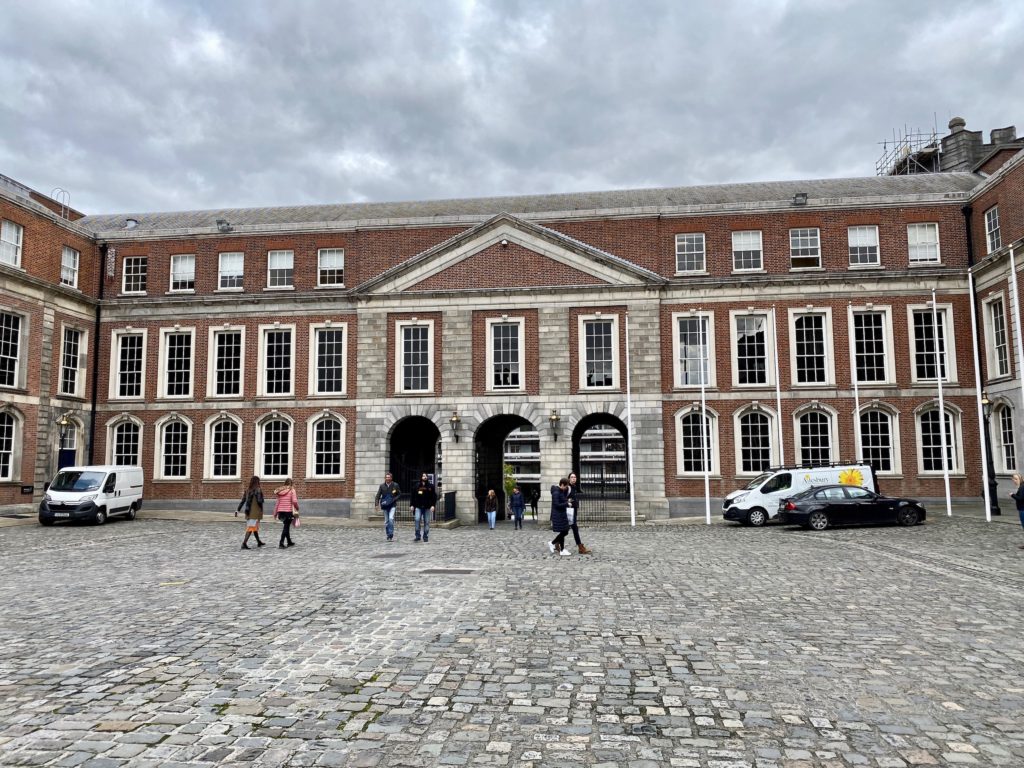
The rest of the buildings of the complex are built in the Georgian style. Similar to those in the English city of Bath, the castle’s courtyards feature buildings with large, linear windows and simple ornamentation. However, unlike those in Bath, these structures are built predominantly in brick and lack any columns or pillars. The use of ornamentation is limited to the stone trim around the windows and the large pediment above the entrance. Today, these buildings feature spaces for state apartments and other government offices. I did not have time to tour them, but I still appreciated the castle’s simple exterior, which felt distinctly different from other Irish and British castles.
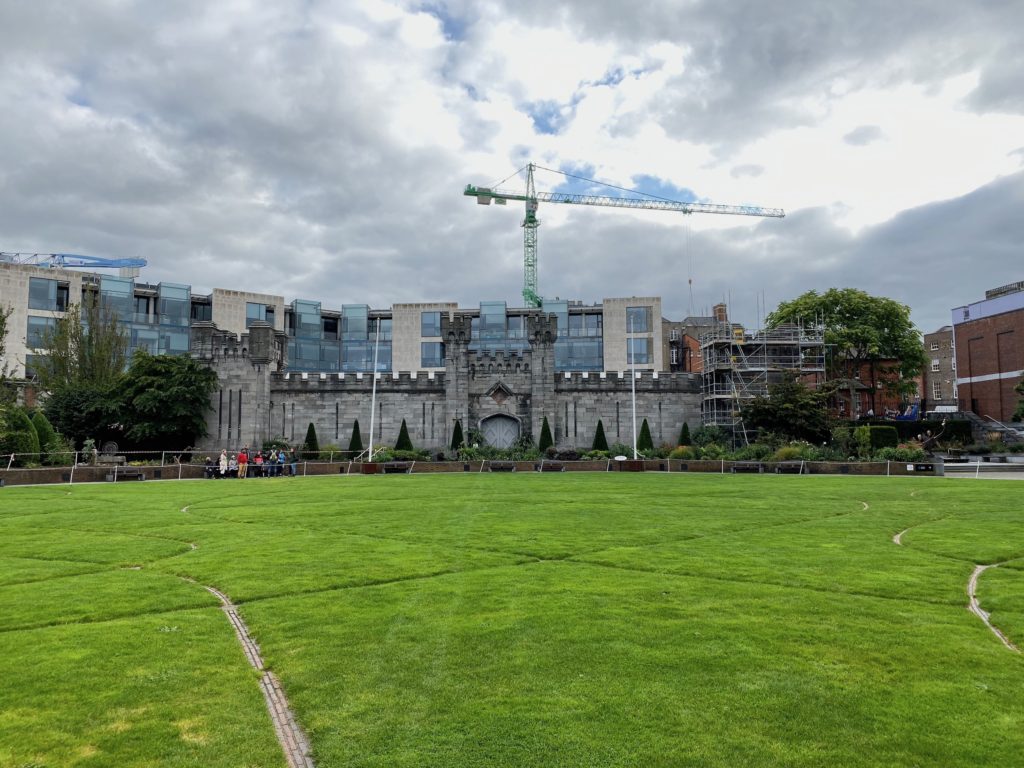
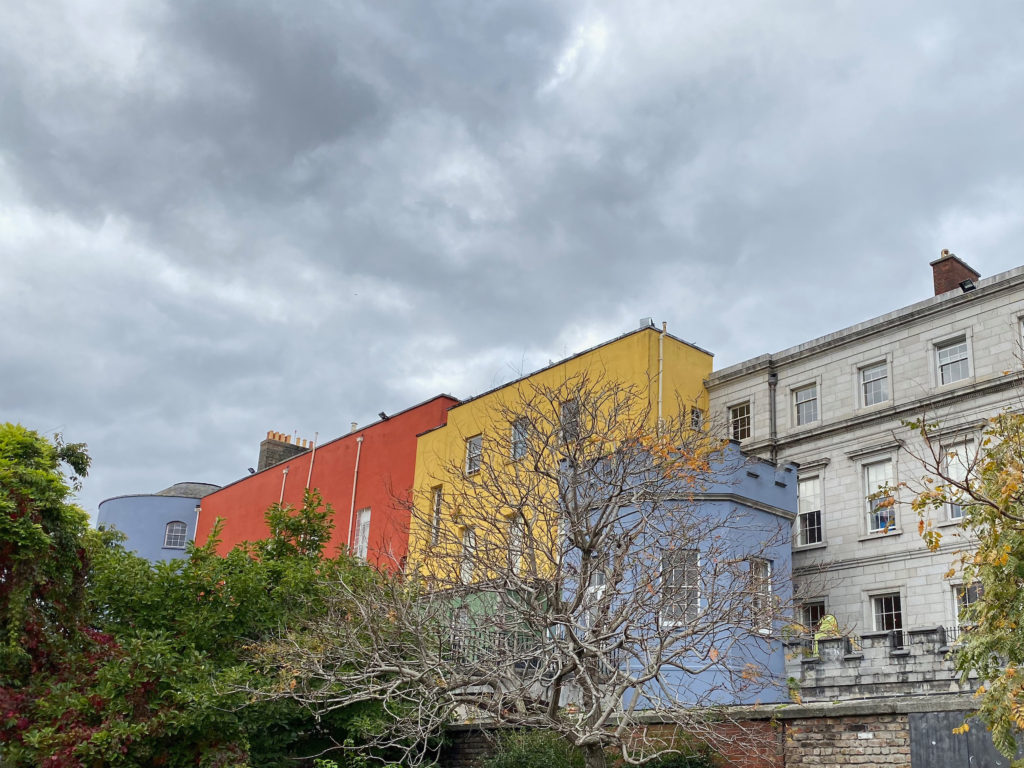
Our guide took us behind the castle to Dubh Linn Garden. Today, this circular green space is a wonderful place to hang out and relax. The central area of the garden features snake-like Celtic symbols placed within the grass. Although it is a park today, this area was once a black pool that harbored Viking ships near the junction of the River Poddle and River Liffey. The pool was called “Dubh Linn” in Irish Gaelic, meaning “Black Pool.” Hence, it gave the city of Dublin its modern name. The park is also a great vantage point for the colorful rear walls of Dublin Castle, which lack the ornamentation of the rest of the
Temple Bar
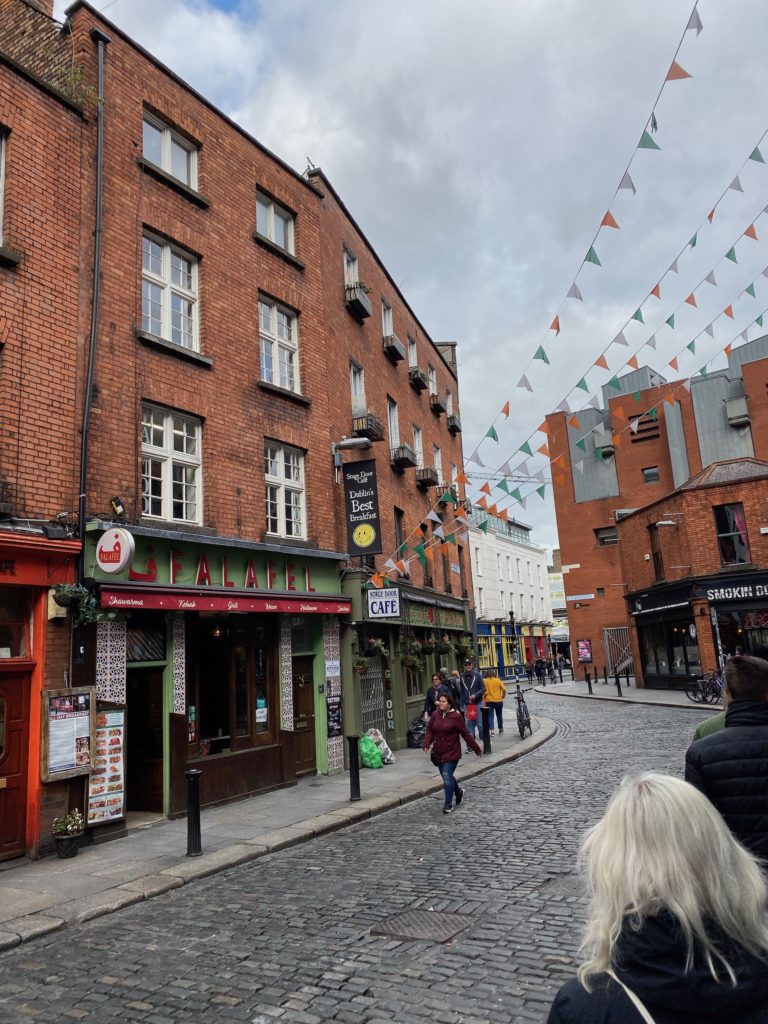
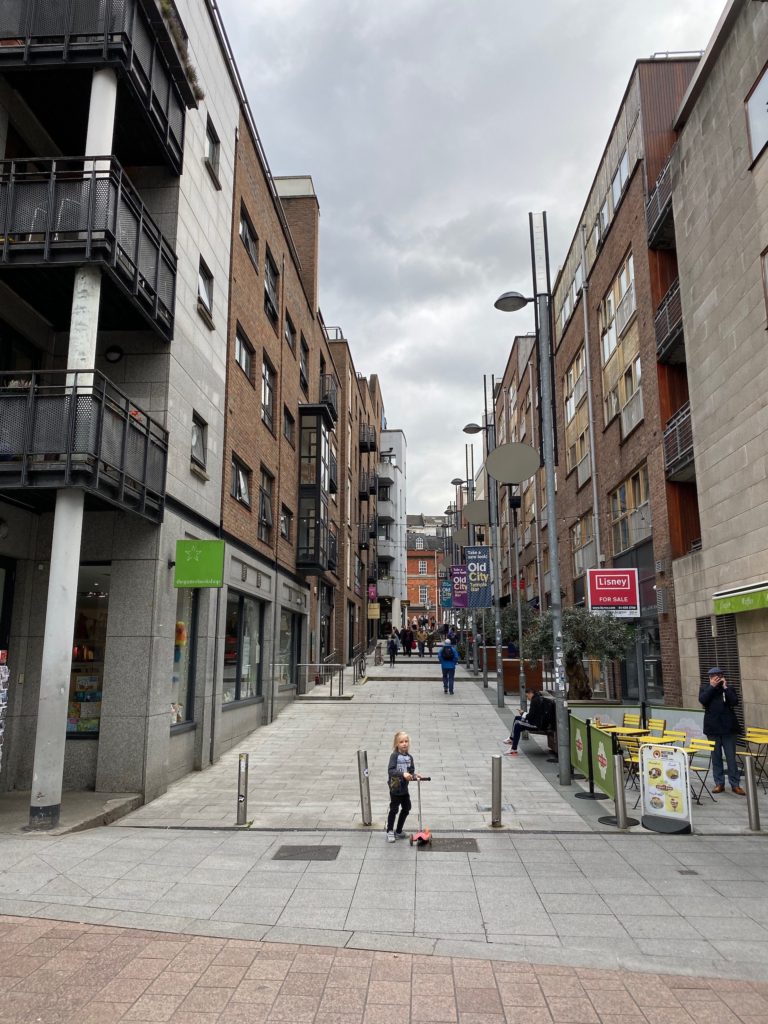
From the gardens, we walked over to Christ Church Cathedral, which I would visit on a later date. Our guide briefly talked about the history of the cathedral before taking us back towards the Temple Bar area. Throughout this neighborhood, I passed by both classical and modern buildings that contain a mix of shops, pubs, and apartments. The older buildings are primarily Georgian-style with simple brick façades. Newer contemporary buildings stand out with their cooler colored materials and prominent metal balconies. The most unique feature of these structures, however, is their whimsical looking shopfronts. These entrances, which vary in color, materials, and ornamentation, harken back to Ireland’s vernacular buildings. They feature architectural inspiration from the Art Nouveau, Classical, and Gothic styles.
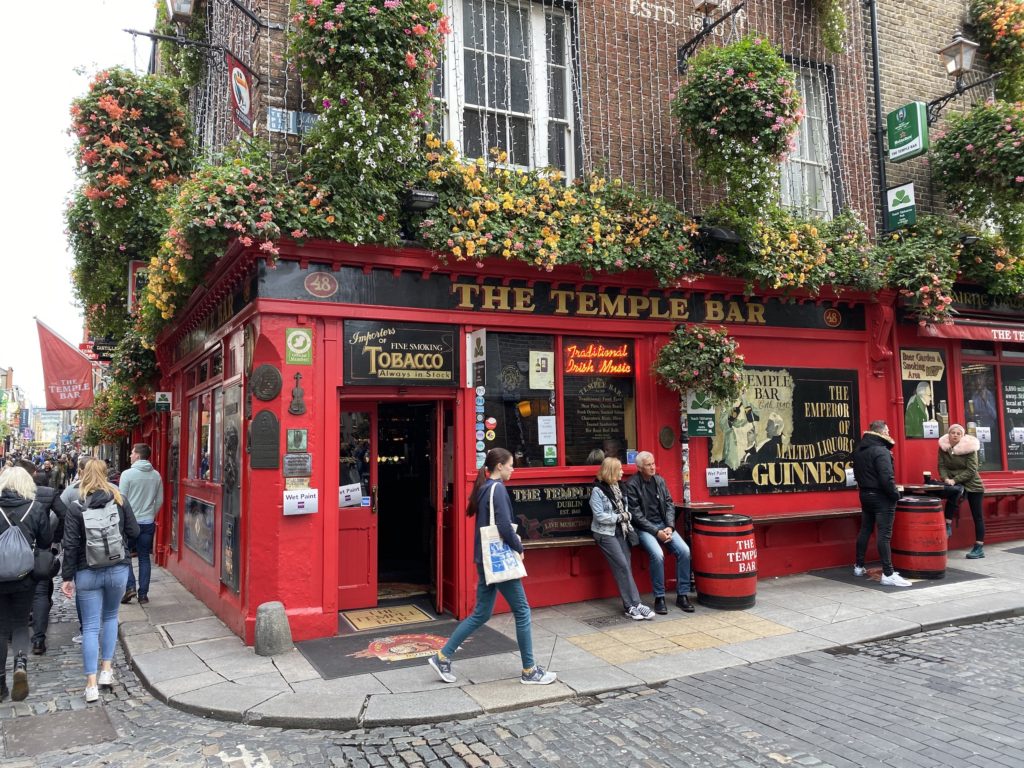
Temple Bar is famous for its classic Irish pubs and vibrant nightlife. Throughout the week, many of these pubs play traditional Irish music and offer a great selection of beer, spirits, and food. The most famous of these is
The Docklands
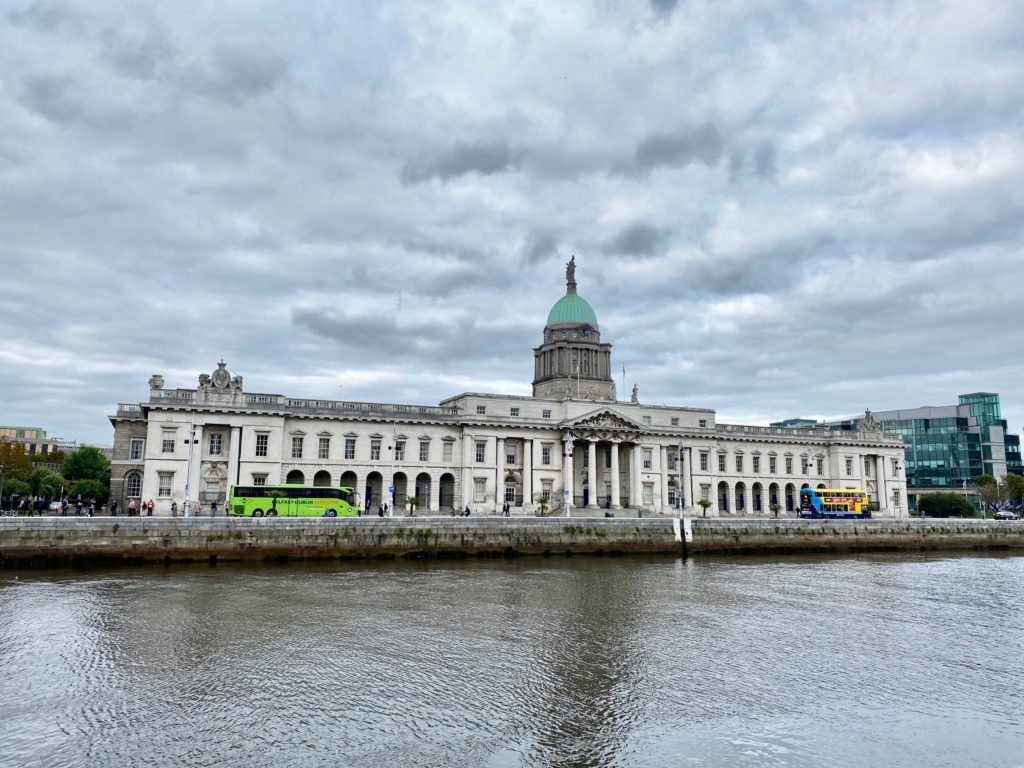
We ended our walking tour back at the River Liffey. From here, I decided to walk along the riverfront and check out some of Dublin’s iconic bridges and other buildings. The first of these is The Custom House: a prominent 18th-century Neoclassical hall. Designed by English architect James Gandon, it is regarded as one of Dublin’s most important architectural landmarks. Although it was controversial at the time of its construction, it is a beautiful masterpiece along the Liffey. It is richly ornamented and boasts four unique façades. The riverfront elevation features linear windows, decorative arcades, and a grand entrance with Tuscan columns and a large pediment. The building is adorned with coats of arms and statues symbolizing Ireland’s rivers, including a 16-foot statue atop the dome.
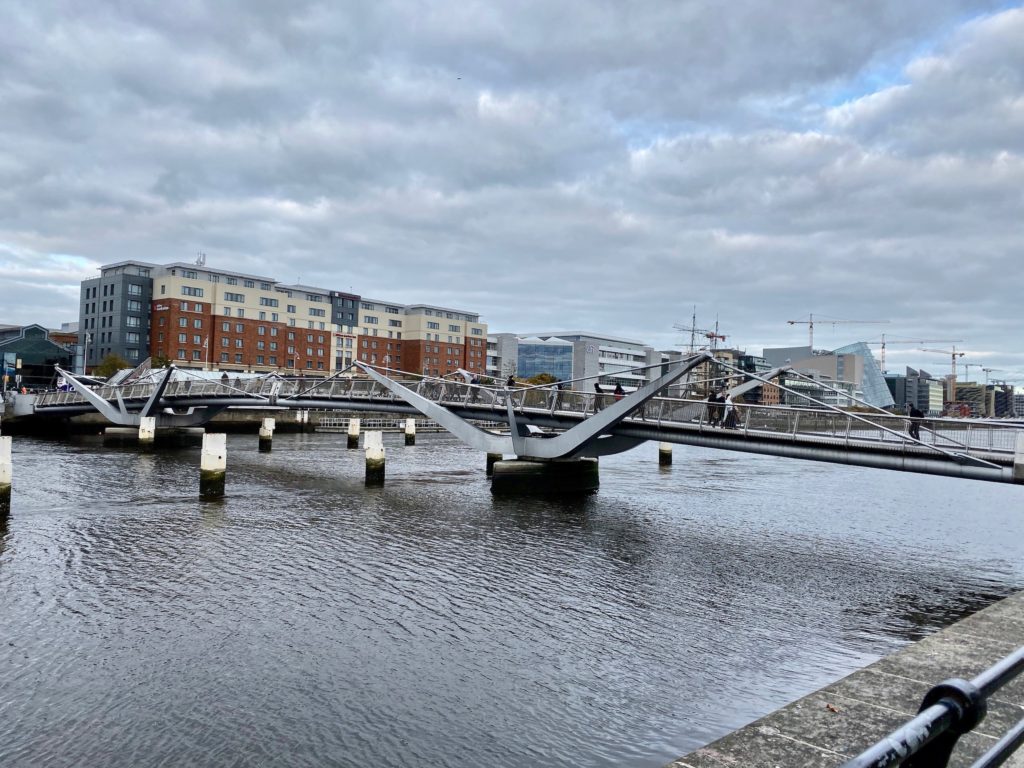
Further down the river, I arrived at one of Dublin’s contemporary bridges. The River Liffey has at least 20 bridges within the city bounds. Most of the bridges around the city’s core are traditional in style. However the closer one gets to the waterfront, the bridges become more elaborate. The Seán O’Casey Bridge is one of these. It opened in 2005 to help revitalize the decaying eastern portion of Dublin’s riverfront known as the “Docklands.” It is a cable-stayed pedestrian bridge with steel supports that veer out from the walkway, reminiscent of the Millennium Bridge in London. Although I did not witness the bridge in action, it is a swing bridge that can open to allow boats to pass. The bridge’s main support system consists of two cantilever arms on piers that also act as swing points.
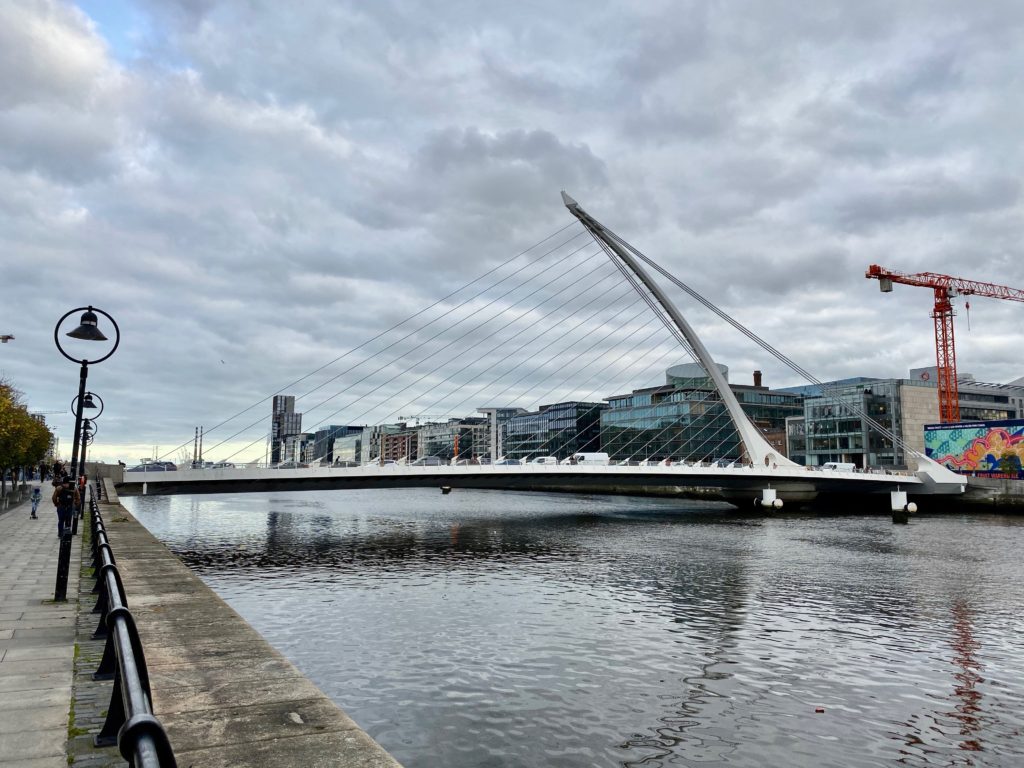
Although impressive, the Seán O’Casey Bridge cannot compare to my favorite architectural landmark in all of Dublin: the Samuel Beckett Bridge. Designed by one of my favorite architects, Santiago Calatrava, this bridge is an icon of the Docklands and opened in 2009. I had previously visited another Calatrava bridge in Bilbao, which stood out for its unique swaying-arched design. Dublin’s bridge, however, is even more elaborate, taking on the appearance of a large harp: a national symbol of Ireland. Much like Calatrava’s other works, this bridge is pure white. The asymmetrical design features a large cantilever spar over a single pier. The arced spar provides the support for the linear steel cables that span the bridge, giving it its harp-like appearance. Much like the Seán O’Casey Bridge, this one also swings open to allow ships to pass by.
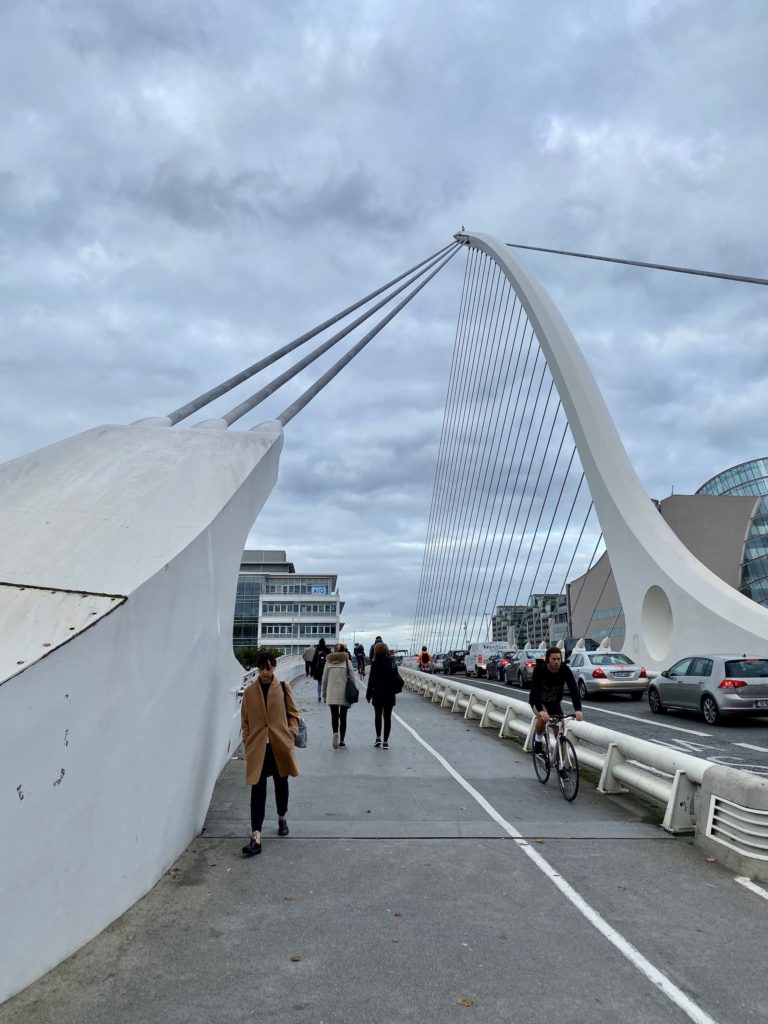
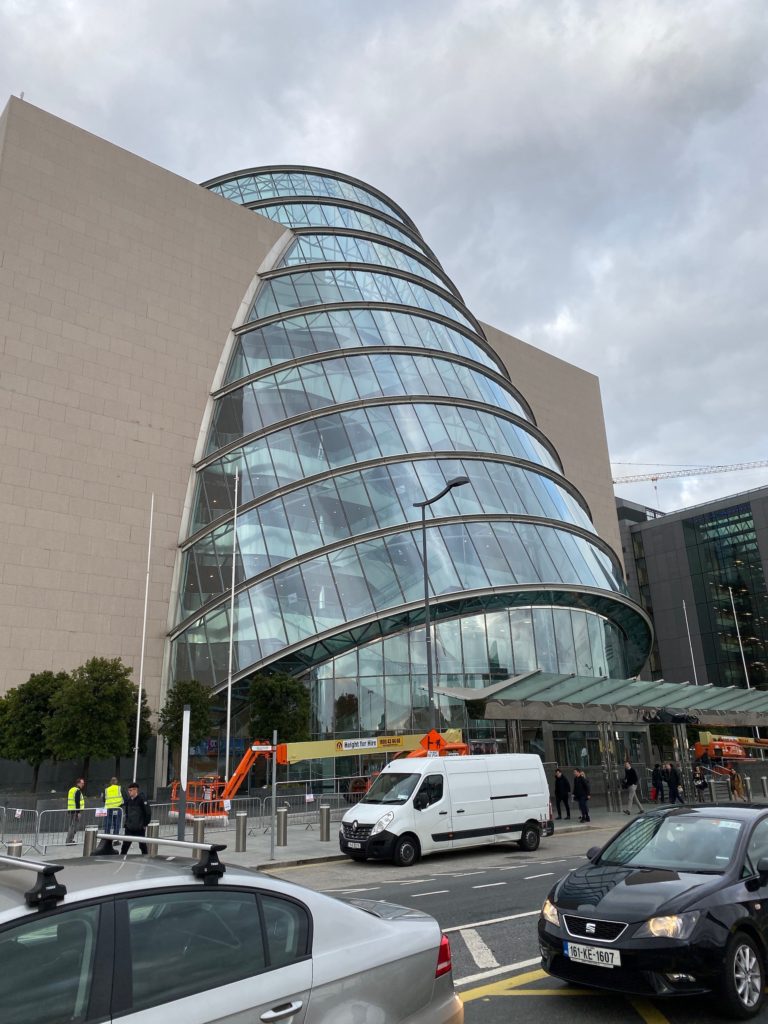
I walked across this bridge and gazed up at its striking structural system. Straight ahead, I could see another iconic building that I wanted to get a look
From here, I walked back down the river towards O’Connell Street, enjoying some people watching on the riverfront as the day turned to dusk. My first taste of Ireland made me appreciate how the country’s population was able to overcome hard times and hold onto a strong identity. While Dublin may have had a gritty past, it is a cosmopolitan city that is distinctly Irish and is evolving into the new millennium.

Great post Samuel! It takes me back to studying abroad in this beautiful city! Hope you got to stop by the Brazen Head for Guinness Stew.
Thanks Veronica! I did not make it to the Brazen Head, but I got to try some Guinness Stew in Galway!
[…] was about halfway through my trip in Ireland. I had already spent some time exploring Dublin, visited some famous landmarks in the city, and even side tripped to Kilkenny and the Wicklow […]
[…] During my walking tour of Dublin, I thoroughly explored the Temple Bar area and other landmarks south of the River Liffey. However, I had yet to walk on two of Dublin’s most notable streets. The first of these is O’Connell Street, which is the city’s main thoroughfare. What started off as just a narrow road is now a wide promenade. A beautiful monument dedicated to Daniel O’Connell exists where the street meets the river. This large statue features the Irish nationalist himself, carved in bronze. Further down the street is a tall stainless steel spire. This 390-foot high monument was commissioned to bring a simple and elegant form of art to the city center. However, the monument is controversial, as many consider it unattractive and lacking in those qualities. […]
1mosquitoes
college paper writing service https://term-paper-help.org/
custom paper writing https://sociologypapershelp.com/
can i pay someone to write my paper https://uktermpaperwriters.com/
pay people to write papers https://paperwritinghq.com/
write my paper for me fast https://writepapersformoney.com/
custom written paper https://write-my-paper-for-me.org/
college paper writing service https://doyourpapersonline.com/
college papers to buy https://top100custompapernapkins.com/
thesis paper help https://researchpaperswriting.org/
best write my paper website https://cheapcustompaper.org/
pay someone to write a paper for me https://writingpaperservice.net/
help me write a paper https://buyessaypaperz.com/
do my college paper https://mypaperwritinghelp.com/
pay for a paper https://writemypaperquick.com/
find someone to write my paper https://essaybuypaper.com/
paper writers https://papercranewritingservices.com/
white paper writing services https://premiumpapershelp.com/
pay for someone to write your paper https://ypaywallpapers.com/
buy custom papers https://studentpaperhelp.com/
2theoretically
coursework writing https://brainycoursework.com/
coursework help uk https://courseworkninja.com/
help with coursework https://writingacoursework.com/
coursework psychology https://mycourseworkhelp.net/
coursework support https://courseworkdownloads.com/
data analysis coursework https://courseworkinfotest.com/
coursework help university https://coursework-expert.com/
custom coursework https://teachingcoursework.com/
coursework service https://buycoursework.org/
coursework help https://courseworkdomau.com/
mature dating sites free no credit card fees https://jewish-dating-online.net/
casual dating https://onlinedatingsurvey.com/
free dating chat https://onlinedatingsuccessguide.com/
dating sites for free https://onlinedatinghunks.com/
free and single https://datingwebsiteshopper.com/
lets-casual-dating https://allaboutdatingsites.com/
dating servie https://freedatinglive.com/
senior dating services https://freewebdating.net/